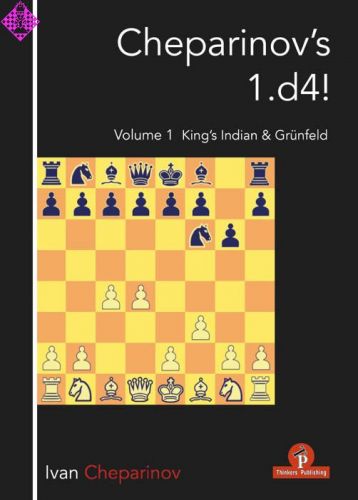Artikelnummer
LOCHEC1D4V1
Autor
Cheparinov's 1. d4! Volume 1
The King's Indian and Grünfeld
200 Seiten, kartoniert, Thinkers Publishing, 1. Auflage 2019
Ivan Cheparinov was born in Bulgaria on 26 November 1986. He learned to play chess at the age of five and progressed quickly, winning the Bulgarian Junior Championship in 2000 and becoming a grandmaster in 2004. He has finished first or equal first in many strong open and elite round-robin tournaments, such as Essent (2006), Morelia (2007), Sigeman & Co invitational (2007), Ruy Lopez Masters (2009 and 2010) and Gibraltar Chess Festival (2014).
Ivan won the national championship of Bulgaria four times (2004, 2005, 2012 and 2018) and tied for first at the European Individual Championship in 2007. After his results in 2007 he crossed the threshold of 2700 for the first time and has since been a regular member of the '2700+' club, with a current peak rating of 2718. He was a long-time second of ex-World Champion Veselin Topalov, also from Bulgaria.
This book marks the start of aseries of four on 1.d4 in which Ivan will share the secrets from two decades analyzing and playing it at the pinnacle of world chess. This volume in particular deals with two of the most popular replies Black can play after 1.d4: the King's Indian and Grünfeld. Ivan presents avantgarde theory with his personal refinements as weil as explanations of the deep strategical nuances that arise after his recommendations.
Ivan won the national championship of Bulgaria four times (2004, 2005, 2012 and 2018) and tied for first at the European Individual Championship in 2007. After his results in 2007 he crossed the threshold of 2700 for the first time and has since been a regular member of the '2700+' club, with a current peak rating of 2718. He was a long-time second of ex-World Champion Veselin Topalov, also from Bulgaria.
This book marks the start of aseries of four on 1.d4 in which Ivan will share the secrets from two decades analyzing and playing it at the pinnacle of world chess. This volume in particular deals with two of the most popular replies Black can play after 1.d4: the King's Indian and Grünfeld. Ivan presents avantgarde theory with his personal refinements as weil as explanations of the deep strategical nuances that arise after his recommendations.
| EAN | 9789492510709 |
|---|---|
| Gewicht | 370 g |
| Hersteller | Thinkers Publishing |
| Breite | 17 cm |
| Höhe | 23,5 cm |
| Medium | Buch |
| Erscheinungsjahr | 2019 |
| Autor | Ivan Cheparinov |
| Sprache | Englisch |
| Auflage | 1 |
| ISBN-13 | 9789492510709 |
| Seiten | 200 |
| Einband | kartoniert |
| Name | Thinkers Publishing BV |
|---|---|
| Adresse | Moorstraat 12 Landegem 9850 Belgien |
| Internet | www.thinkerspublishing.com |
| KnightToF3@hotmail.com |
004 Key to Symbols
006 Preface
009 Chapter 1 Early Sidelines
037 Chapter 2 Benoni Structures
063 Chapter 3 The Grünfeld
139 Chapter 4 The King’s Indian Sämisch
006 Preface
009 Chapter 1 Early Sidelines
037 Chapter 2 Benoni Structures
063 Chapter 3 The Grünfeld
139 Chapter 4 The King’s Indian Sämisch
An Embarrassment of Riches: New Books on the Grünfeld reviewed by IM John Donaldson
·The Modernized Grünfeld Defense by Yaroslav Zherbukh (Thinkers Publishing)
·Playing the Grünfeld: A Combative Repertoire by Alexey Kovalchuk (Quality Chess)
Back in 1971 William Hartston wrote the first book in English on the Grünfeld and over the next half century a number of excellent words have been published including a ground breaking two volume series by Boris Avrukh. Published by Quality Chess in 2011, it was over 600 pages, and set a high bar for successors. Three worthy challengers have appeared the past year. The Safest Grünfeld Reloaded (Chess Stars 2019) by Alexander Delchev is not part of this review but new books from Quality Chess and Thinkers Publishing are.
The Modernized Grünfeld Defense and Playing the Grünfeld: A Combative Repertoire are excellent, but quite different books and the easiest way to see this by comparing variations the authors recommend.
1.d4 Nf6 2.c4 g6 3.f3
Kovalchuk 3…c5
Zherebukh 3…d5
1.d4 Nf6 2.c4 g6 3.g3
Kovalchuk 3…c6
Zherebukh 3…Bg7 4.Bg2 d5
1.d4 Nf6 2.c4 g6 3.Nc3 d5 4.Nf3 Bg7 5.Qb3 dxc4 6.Qxc4 0-0 7.e4
Kovalchuk 7…a6
Zherebukh 7…Nc6
1.d4 Nf6 2.c4 g6 3.Nc3 d5 4.Nf3 Bg7 5.Bg5
Kovalchuk 5…Ne4
Zherebukh 5…dxc4
1.d4 Nf6 2.c4 g6 3.Nc3 d5 4.Nf3 Bg7 5.h4
Kovalchuk 5…c6
Zherebukh 5…dxc4
One might think the authors made a secret pact not to cover the same lines, but the differences appear to be fundamental. Zherebukh, 2600 plus rated and a GM at 15, in many cases advocates for lesser or unknown systems. He believes in playing the Grünfeld aggressively and that often means sacrificing material in the lines he recommends.
Kovalchuk, who has worked as a trainer for top Russian GMs, advocates for a more mainstream approach, toning down Black’s play where he believes it warranted. This means …c6 against the Fianchetto variation and after 1.d4 Nf6 2.c4 g6 3.Nc3 d5 4.Nf3 Bg7 5.h4. Zherebukh seemingly never wants to play …c6 preferring …c5 or …dxc4 followed up later by …c5.
Which book to get? That is a tough question to answer. Both are first rate and to a certain extent if you already play the Grünfeld the book to get might be the one that most closely matches your existing repertoire.
Correspondence players may prefer Kovalchuk’s comprehensive approach that covers sidelines more thoroughly than Zherebukh, but the latter has done major pioneering work with novelties sprinkled throughout his book. Zherebukh’s perceptive comments, in such a theoretical opening as the Grünfeld, are helpful in orienting the reader through the unavoidable maze of variations.
Quality Chess is known for providing comprehensive indexes for its books and Playing the Grünfeld devotes seven of its pages to this important resource. The Modernized Grünfeld Defense doesn’t have an index but it does offer over 40 pages on Anti-Grunfeld lines (1.c4 Nf6 2.Nf3 g6 3.Nc3 d5 4.cxd5 and 4.Qa4+) while Playing the Grünfeld confines itself to 1.d4 Nf6 2.c4 g6 3.Nc3, 3.f3 and 3.g3.
The latter covers the sneaky 1.d4 Nf6 2.c4 g6 3.Nf3 Bg7 4.e3 0-0 5.Be2 hoping for 5…d5 6.cxd5 Nxd5 7.e4 where there is no …Nxc3 but White has spent two moves advancing his e-pawn. This system is not analyzed by Zherebukh while Kovanchuk recommends 5…b6 which has been the choice of Grünfeld specialists Vachier-Lagrave and Nepomniachti.
Whichever your choice and my recommendation finances permitting would be to get both books, keep in mind there is no free lunch in chess. The Grunfeld has a well-deserved reputation as one of Black’s best answers to 1.d4, with no clear route to a White advantage. However, it does require a significant amount of theoretical knowledge. Zherebukh suggests memorizing the first fifteen moves of each major line as the bare minimum and offers various tips on how to do so.
If this sounds daunting check out the third book on the Grunfeld which is actually an all-purpose system for White to combat the Grünfeld and King’s Indian with 1.d4 Nf6 2.c4 g6 3.f3. 2700 rated Grandmaster Ivan Cheparinov covers all of Black’s possibilities from transposing into the Sämisch, Benoni and Grünfeld (3…d6 , 3…c5 and 3…d5) to lesser known alternatives like 3…Nc6 and 3…e6. To say Cheparinov’s coverage is exhaustive would be an understatement and it is easy to see why he was Topalov’s second during his days as World Champion. The lines in this book routinely go 20 to 25 moves deep and in some cases up to move 40!
Explanatory prose is provided to assist the reader but concrete lines are the heart of Cheparinov’s 1.d4! Volume 1 King’s Indian & Grünfeld Some amateurs might mistakenly believe they can reproduce Cheparinov’s analysis using a strong computer engine but they would be grossly mistaken. It takes a world class grandmaster with a strong work ethic and deep knowledge of opening theory to produce a work like this which is aimed only at the most serious and ambitious.
IM John Donaldson
·The Modernized Grünfeld Defense by Yaroslav Zherbukh (Thinkers Publishing)
·Playing the Grünfeld: A Combative Repertoire by Alexey Kovalchuk (Quality Chess)
·Cheparinov’s 1.d4! Volume 1 King’s Indian & Grünfeld by Ivan Cheparinov (Thinkers Publishing)
The Grünfeld enjoys a special place in the pantheon of openings. One need only recall that two of Bobby Fischer’s most famous brilliancies, played against the Byrne brothers, both featured this dynamic defense which is named after the Austrian Grandmaster Ernst Franz Grünfeld.Back in 1971 William Hartston wrote the first book in English on the Grünfeld and over the next half century a number of excellent words have been published including a ground breaking two volume series by Boris Avrukh. Published by Quality Chess in 2011, it was over 600 pages, and set a high bar for successors. Three worthy challengers have appeared the past year. The Safest Grünfeld Reloaded (Chess Stars 2019) by Alexander Delchev is not part of this review but new books from Quality Chess and Thinkers Publishing are.
The Modernized Grünfeld Defense and Playing the Grünfeld: A Combative Repertoire are excellent, but quite different books and the easiest way to see this by comparing variations the authors recommend.
1.d4 Nf6 2.c4 g6 3.f3
Kovalchuk 3…c5
Zherebukh 3…d5
1.d4 Nf6 2.c4 g6 3.g3
Kovalchuk 3…c6
Zherebukh 3…Bg7 4.Bg2 d5
1.d4 Nf6 2.c4 g6 3.Nc3 d5 4.Nf3 Bg7 5.Qb3 dxc4 6.Qxc4 0-0 7.e4
Kovalchuk 7…a6
Zherebukh 7…Nc6
1.d4 Nf6 2.c4 g6 3.Nc3 d5 4.Nf3 Bg7 5.Bg5
Kovalchuk 5…Ne4
Zherebukh 5…dxc4
1.d4 Nf6 2.c4 g6 3.Nc3 d5 4.Nf3 Bg7 5.h4
Kovalchuk 5…c6
Zherebukh 5…dxc4
One might think the authors made a secret pact not to cover the same lines, but the differences appear to be fundamental. Zherebukh, 2600 plus rated and a GM at 15, in many cases advocates for lesser or unknown systems. He believes in playing the Grünfeld aggressively and that often means sacrificing material in the lines he recommends.
Kovalchuk, who has worked as a trainer for top Russian GMs, advocates for a more mainstream approach, toning down Black’s play where he believes it warranted. This means …c6 against the Fianchetto variation and after 1.d4 Nf6 2.c4 g6 3.Nc3 d5 4.Nf3 Bg7 5.h4. Zherebukh seemingly never wants to play …c6 preferring …c5 or …dxc4 followed up later by …c5.
Which book to get? That is a tough question to answer. Both are first rate and to a certain extent if you already play the Grünfeld the book to get might be the one that most closely matches your existing repertoire.
Correspondence players may prefer Kovalchuk’s comprehensive approach that covers sidelines more thoroughly than Zherebukh, but the latter has done major pioneering work with novelties sprinkled throughout his book. Zherebukh’s perceptive comments, in such a theoretical opening as the Grünfeld, are helpful in orienting the reader through the unavoidable maze of variations.
Quality Chess is known for providing comprehensive indexes for its books and Playing the Grünfeld devotes seven of its pages to this important resource. The Modernized Grünfeld Defense doesn’t have an index but it does offer over 40 pages on Anti-Grunfeld lines (1.c4 Nf6 2.Nf3 g6 3.Nc3 d5 4.cxd5 and 4.Qa4+) while Playing the Grünfeld confines itself to 1.d4 Nf6 2.c4 g6 3.Nc3, 3.f3 and 3.g3.
The latter covers the sneaky 1.d4 Nf6 2.c4 g6 3.Nf3 Bg7 4.e3 0-0 5.Be2 hoping for 5…d5 6.cxd5 Nxd5 7.e4 where there is no …Nxc3 but White has spent two moves advancing his e-pawn. This system is not analyzed by Zherebukh while Kovanchuk recommends 5…b6 which has been the choice of Grünfeld specialists Vachier-Lagrave and Nepomniachti.
Whichever your choice and my recommendation finances permitting would be to get both books, keep in mind there is no free lunch in chess. The Grunfeld has a well-deserved reputation as one of Black’s best answers to 1.d4, with no clear route to a White advantage. However, it does require a significant amount of theoretical knowledge. Zherebukh suggests memorizing the first fifteen moves of each major line as the bare minimum and offers various tips on how to do so.
If this sounds daunting check out the third book on the Grunfeld which is actually an all-purpose system for White to combat the Grünfeld and King’s Indian with 1.d4 Nf6 2.c4 g6 3.f3. 2700 rated Grandmaster Ivan Cheparinov covers all of Black’s possibilities from transposing into the Sämisch, Benoni and Grünfeld (3…d6 , 3…c5 and 3…d5) to lesser known alternatives like 3…Nc6 and 3…e6. To say Cheparinov’s coverage is exhaustive would be an understatement and it is easy to see why he was Topalov’s second during his days as World Champion. The lines in this book routinely go 20 to 25 moves deep and in some cases up to move 40!
Explanatory prose is provided to assist the reader but concrete lines are the heart of Cheparinov’s 1.d4! Volume 1 King’s Indian & Grünfeld Some amateurs might mistakenly believe they can reproduce Cheparinov’s analysis using a strong computer engine but they would be grossly mistaken. It takes a world class grandmaster with a strong work ethic and deep knowledge of opening theory to produce a work like this which is aimed only at the most serious and ambitious.
IM John Donaldson
Mehr von Thinkers Publishing
-
 La Defensa Philidor Modernizada29,95 €
La Defensa Philidor Modernizada29,95 € -
 Kings of the Chessboard26,95 €
Kings of the Chessboard26,95 € -
 Key Concepts of Chess - vol. 124,95 €
Key Concepts of Chess - vol. 124,95 € -
 Ivan´s Chess Journey17,50 € Regular Price 29,80 €
Ivan´s Chess Journey17,50 € Regular Price 29,80 € -
 Koningen van het Schaakbord24,95 €
Koningen van het Schaakbord24,95 € -
 Learn from Michal Krasenkow30,95 €
Learn from Michal Krasenkow30,95 € - Mehr von Thinkers Publishing


